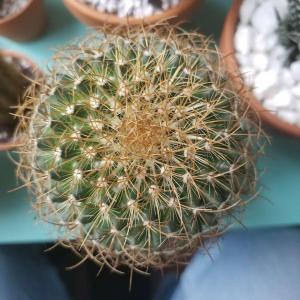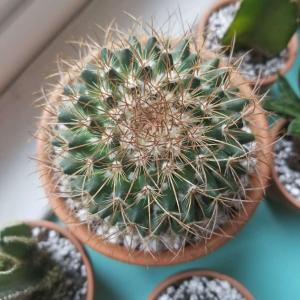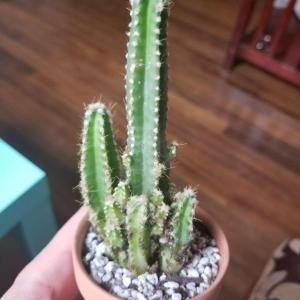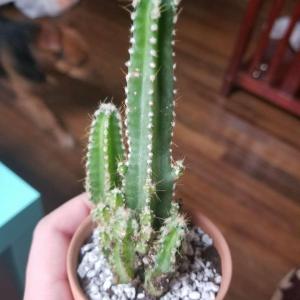求助
Nicole Rebecca Vincent
2017年09月13日

Identification??
I think this may be "old lady cactus" but I'm unsure.
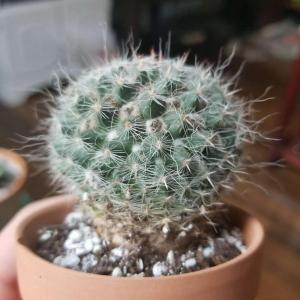
I think this may be "old lady cactus" but I'm unsure.

0
0
求助
Nicole Rebecca Vincent
2017年09月13日

Identification??
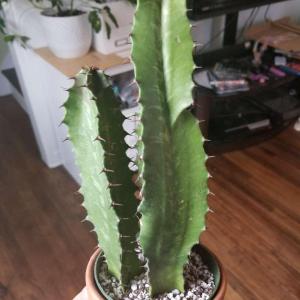
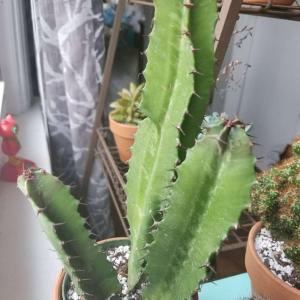


1
0
Mohamad.hamidizade:No euphorbia agnas
Ueca:Euphorbia trigona
求助
Nicole Rebecca Vincent
2017年09月13日

Identification??
I think it might be "Mexican fence post" but I'm unsure.
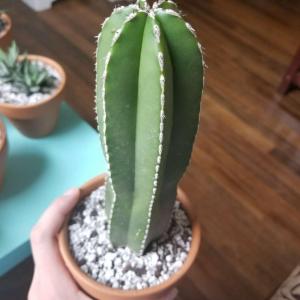
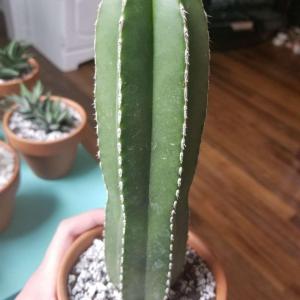
I think it might be "Mexican fence post" but I'm unsure.


0
0
meriunkat:yes that is it's name, I searched it on Google
文章
Dummer. ゛☀
2017年09月13日

Identification
The tomato hornworm, Manduca quinquemaculata, is much dreaded by vegetable gardeners, because they can devastate tomatoes and other members of the nightshade ( Solanaceae) family, such as eggplants and peppers. However, the tomato hornworm and tobacco hornworm, Manduca sexta, are often confused with each other. They are very similar in appearance and both attack members of the Solanaceae family.
The tomato hornworm is three to four inches long at full size (likely to be the biggest caterpillar we see in our gardens) and green in color, with white V-shaped marks along its sides. A black "horn" projects from the rear of the caterpillar. Tobacco hornworms, on the other hand, have diagonal white stripes and a red "horn." Both are treated in the same way when they attack your garden.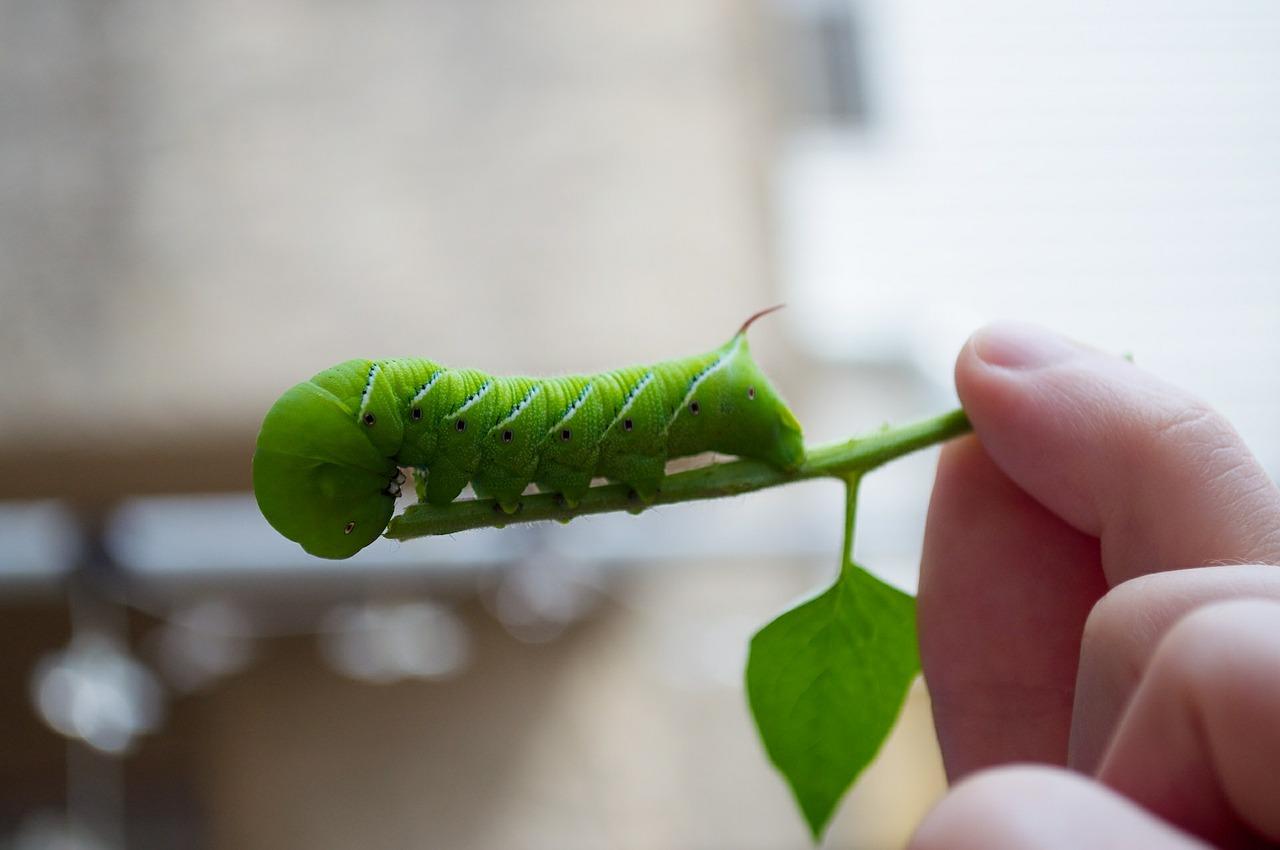
Life Cycle
The tomato hornworm represents the larval stage of the hawk or sphinx moth, also known as hummingbird moths. The moths overwinter in the soil as dark brown pupae, then emerge and mate in late spring. They lay their eggs, which are round and greenish-white, on the undersides of leaves. The eggs hatch in four to five days and the hornworm emerges. It spends the next four weeks growing to full size, after which it will make its way into the soil to pupate.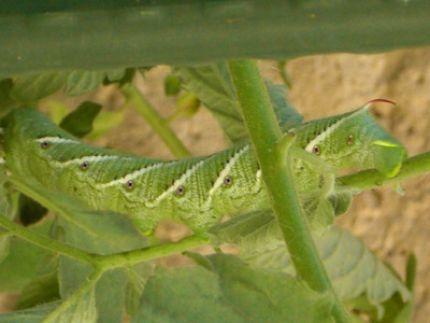
Signs of Tomato Hornworms
Tomato hornworms are voracious pests, munching entire leaves, small stems and even parts of the immature fruit.
While they are most commonly associated with tomatoes, hornworms are also common pests of eggplants, peppers, and potatoes. Most likely, you'll notice the damage before you notice the hornworms because their color helps them blend in so well with the plant foliage. You can also look for their black frass (droppings) on the foliage and around the base of the plant.
Effect on Garden Plants
Undetected, a tomato hornworm can do a fair amount of damage to its host plant. They have hearty appetites and can defoliate a plant in a matter of days. If they are detected and removed early on, the plant will recover just fine.
Organic Control for Tomato Hornworm
Because the hornworm is so large, the easiest and most effective way to get rid of it is to pick it off of plants as soon as you detect it, and either crush it or toss it into a bowl of soapy water. A bad infestation can be treated by applying BT (Bacillus thuringiensis). This is most effective when the larvae are small. If worms are a problem year after year, try rototilling the soil either in late fall or in spring before you plant--this will either bury the pupae or destroy them.
However, if you see a hornworm covered with white egg sacs, leave it be. The egg sacs are those of a parasitic wasp called the Braconid wasp. Let the eggs hatch, and you'll have an army of wasps ready to defend your garden against all types of pests. These wasps are not a threat to humans.
Another organic method for killing tomato hornworms is mix liquid soap and water together and spray it onto the plant foliage, then sprinkle cayenne pepper over the foliage and fruit.
The soap solution will kill the worms, while the Cayenne repels them if the soap washes off. This treatment will need to be repeated after each heavy rain, however.
Chemical Control for Tomato Hornworms
The synthetic chemical Carbaryl will kill tomato hornworms along with many other pests. However, it is highly toxic and is discouraged for use on edibles. Wherever possible, rely on organic methods to control tomato hornworms, as well as other garden pests.
The tomato hornworm, Manduca quinquemaculata, is much dreaded by vegetable gardeners, because they can devastate tomatoes and other members of the nightshade ( Solanaceae) family, such as eggplants and peppers. However, the tomato hornworm and tobacco hornworm, Manduca sexta, are often confused with each other. They are very similar in appearance and both attack members of the Solanaceae family.

The tomato hornworm is three to four inches long at full size (likely to be the biggest caterpillar we see in our gardens) and green in color, with white V-shaped marks along its sides. A black "horn" projects from the rear of the caterpillar. Tobacco hornworms, on the other hand, have diagonal white stripes and a red "horn." Both are treated in the same way when they attack your garden.

Life Cycle
The tomato hornworm represents the larval stage of the hawk or sphinx moth, also known as hummingbird moths. The moths overwinter in the soil as dark brown pupae, then emerge and mate in late spring. They lay their eggs, which are round and greenish-white, on the undersides of leaves. The eggs hatch in four to five days and the hornworm emerges. It spends the next four weeks growing to full size, after which it will make its way into the soil to pupate.

Signs of Tomato Hornworms
Tomato hornworms are voracious pests, munching entire leaves, small stems and even parts of the immature fruit.
While they are most commonly associated with tomatoes, hornworms are also common pests of eggplants, peppers, and potatoes. Most likely, you'll notice the damage before you notice the hornworms because their color helps them blend in so well with the plant foliage. You can also look for their black frass (droppings) on the foliage and around the base of the plant.

Effect on Garden Plants
Undetected, a tomato hornworm can do a fair amount of damage to its host plant. They have hearty appetites and can defoliate a plant in a matter of days. If they are detected and removed early on, the plant will recover just fine.
Organic Control for Tomato Hornworm
Because the hornworm is so large, the easiest and most effective way to get rid of it is to pick it off of plants as soon as you detect it, and either crush it or toss it into a bowl of soapy water. A bad infestation can be treated by applying BT (Bacillus thuringiensis). This is most effective when the larvae are small. If worms are a problem year after year, try rototilling the soil either in late fall or in spring before you plant--this will either bury the pupae or destroy them.

However, if you see a hornworm covered with white egg sacs, leave it be. The egg sacs are those of a parasitic wasp called the Braconid wasp. Let the eggs hatch, and you'll have an army of wasps ready to defend your garden against all types of pests. These wasps are not a threat to humans.
Another organic method for killing tomato hornworms is mix liquid soap and water together and spray it onto the plant foliage, then sprinkle cayenne pepper over the foliage and fruit.
The soap solution will kill the worms, while the Cayenne repels them if the soap washes off. This treatment will need to be repeated after each heavy rain, however.

Chemical Control for Tomato Hornworms
The synthetic chemical Carbaryl will kill tomato hornworms along with many other pests. However, it is highly toxic and is discouraged for use on edibles. Wherever possible, rely on organic methods to control tomato hornworms, as well as other garden pests.
0
0
文章
Dummer. ゛☀
2017年08月15日

Allium subvillosum is an attractive plant, but to appreciate its true beauty you need to get close up and personal because it has such tiny flowers.
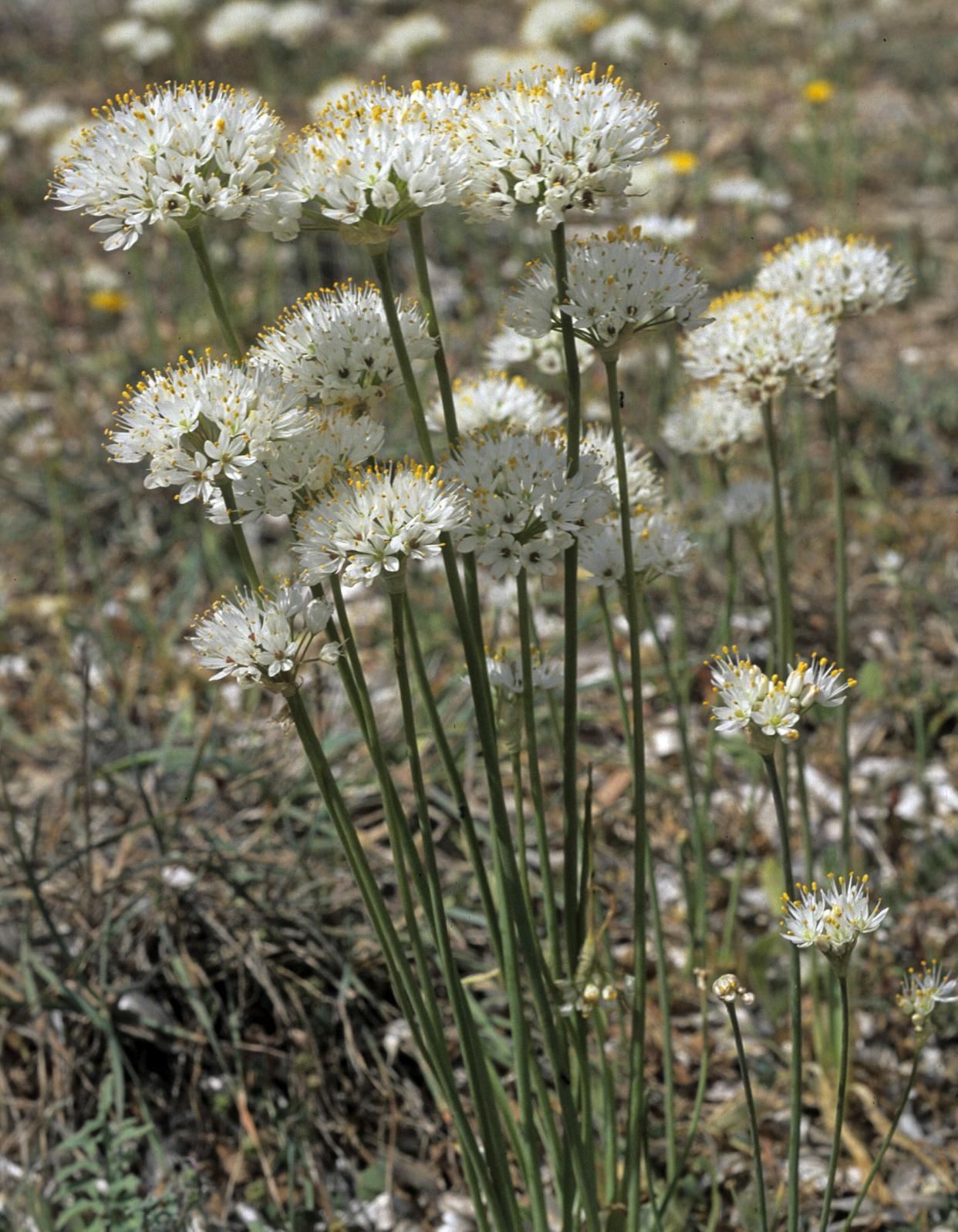
Identification
A relative of Wild Garlic (also known as Ramsons), Allium subvillosum has dense umbels each with 15 to 20 white flowers that are deeply cupped and have yellow anthers. This bulb-forming perennial grows up to 30cm tall, and its long narrow leaves are covered with long white hairs.
Allium subvillosum was until recently classified as a member of the Lily family (Liliaceae), but recent taxonomic revisions now place it in the family Asparagaceae.

Distribution
These spring wildflowers are found in southern Spain and Portugal, Sicily, North Africa and the Balearics.
Habitat
This coastal plant of the Mediterranean region can be found in both sandy and grassy places close to the sea.
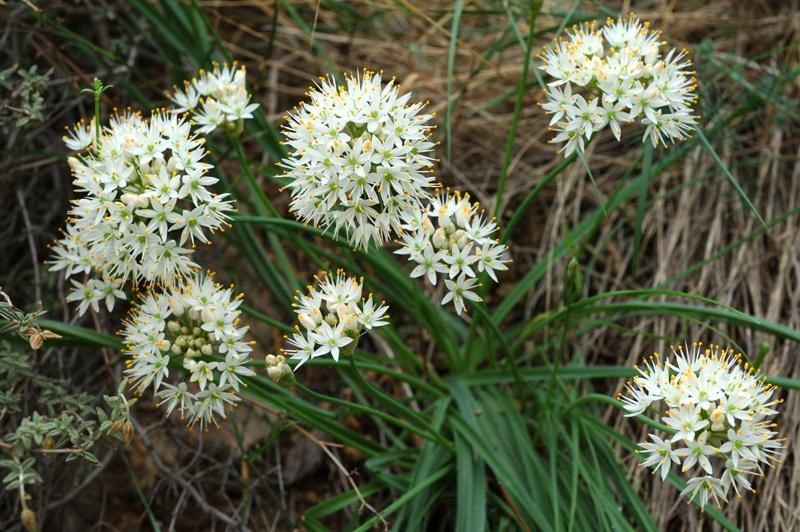
Blooming Times
Allium subvillosum blooms very early in the year. The specimens shown on this page were photographed in the Algarve region of Portugal in late February.
Etymology
Allium is the Latin word for garlic, while the specific epithet subvillosum comes from sub- meaning somewhat or slightly, and -villosum meaning covered in soft hairs.

Identification
A relative of Wild Garlic (also known as Ramsons), Allium subvillosum has dense umbels each with 15 to 20 white flowers that are deeply cupped and have yellow anthers. This bulb-forming perennial grows up to 30cm tall, and its long narrow leaves are covered with long white hairs.
Allium subvillosum was until recently classified as a member of the Lily family (Liliaceae), but recent taxonomic revisions now place it in the family Asparagaceae.

Distribution
These spring wildflowers are found in southern Spain and Portugal, Sicily, North Africa and the Balearics.
Habitat
This coastal plant of the Mediterranean region can be found in both sandy and grassy places close to the sea.

Blooming Times
Allium subvillosum blooms very early in the year. The specimens shown on this page were photographed in the Algarve region of Portugal in late February.
Etymology
Allium is the Latin word for garlic, while the specific epithet subvillosum comes from sub- meaning somewhat or slightly, and -villosum meaning covered in soft hairs.
0
0
文章
Dummer. ゛☀
2017年08月15日

Anyone who says they love the scent of spring flowers obviously hasn't caught a whiff of these stinkers, especially when they are fading.
Identification
Smyrnium olusatrum is a hairless biennial umbellifer growing to a height of 1.5m. The yellowish-green glossy leaves are divided and bluntly toothed. Young stems are solid but become hollow when old; the upper branches are usually opposite.
Borne in dense umbels, the yellowish Flowers of Alexanders are hermaphrodite (having both male and female reproductive organs); they have no sepals. The seeds change colour from light green to black as they ripen during July and August..

Distribution
This Mediterranean plant was probably introduced to Britainby the Romans, who may have used it as a general-purpose vegetable. (The leaves and young shoots can be eaten either raw or cooked, although the bitter taste is not universally popular.) Alexanders grows wild in most coastal parts of Britain and Ireland, and in southern and central Britain it is also found in many inland locations. Further north this warm-climate cannot cope inland with winter's extreme cold, and it is confined to sheltered coastal areas.
Smyrnium olusatrum is common throughout central and southern mainland Europe
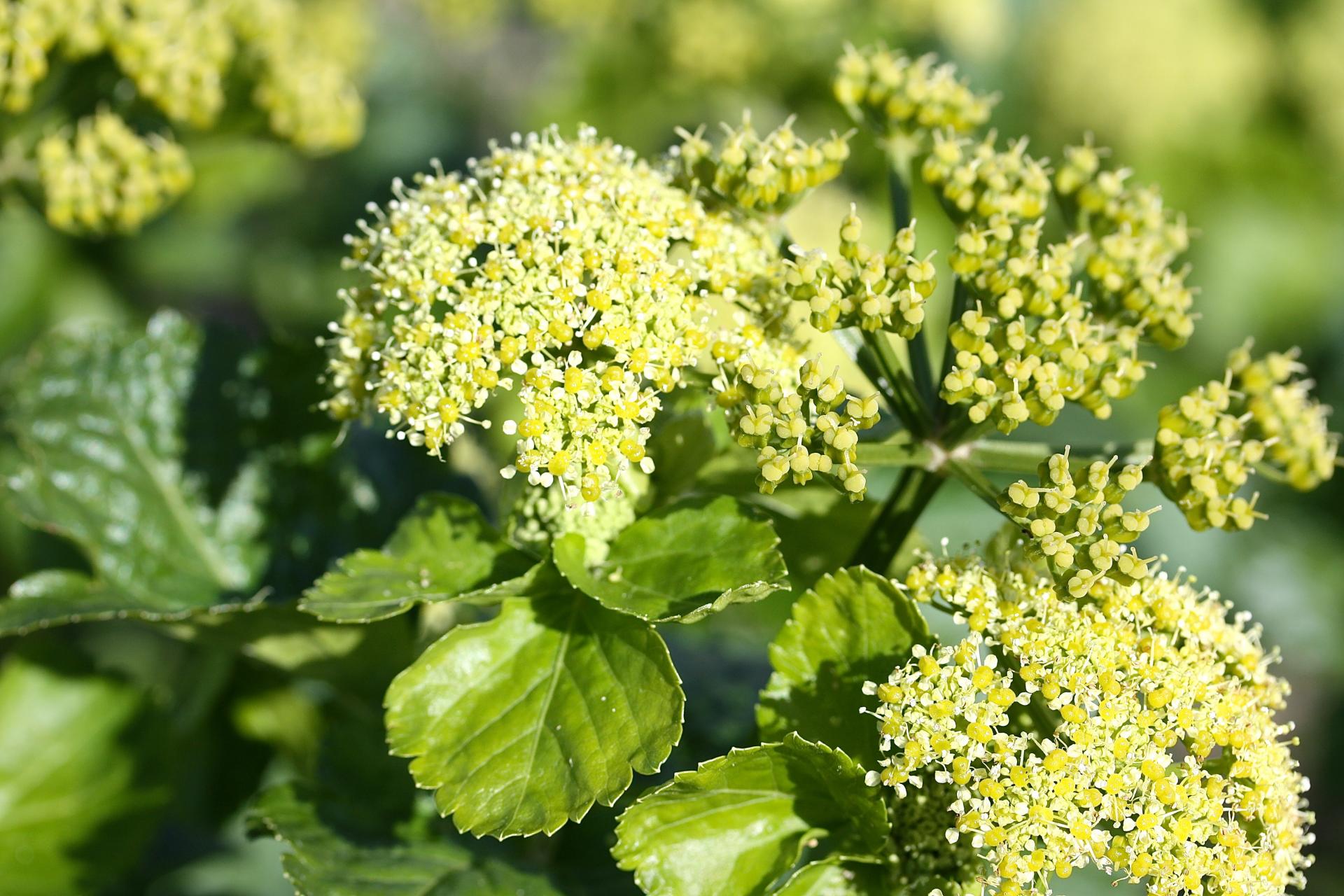
Habitat
Particularly were the soil is enriched and has been disturbed, Alexanders colonises waste land, roadside verges, woodland edges, scrub and and cliff tops.
Although mainly coastal, this umbellifer seems to have benefited from the salting of roads, and so has moved inland nearly always on or near roadside verges.
Blooming Times
This mainly coastal plant is a very early blooming member of the family Apiaceae, and you will see swathes of it in springtime along hedgerows and onthe slopes leading down to sheltered coves.
The umbrella-like yellow flower heads open in April, and by July the seeds are beginning to ripen and turn dark brown.

Uses
All parts of this plant are considered edible, but older leaves and stems are usually cooked; only young leaves and shoots are worth adding raw to salads. The first new leaves appear during winter, before many other edible wild plants are available. In the distant past Smyrnium olusatrum was used in many herbal remedies, but nowadays other plants are generally considered superior. (We strongly advise against eating or using as medicines any plants without first obtaining qualified professional advice.)
Etymology
The generic botanical name Smyrnium comes from the Greek word smyrnion, which means myrrh. It suggests that the smells of Alexanders and of myrrh may be similar.The specific epithet olusatrum comes from the Latin olus-, a garden herb, and -ater, black - referring to the seeds.
Identification
Smyrnium olusatrum is a hairless biennial umbellifer growing to a height of 1.5m. The yellowish-green glossy leaves are divided and bluntly toothed. Young stems are solid but become hollow when old; the upper branches are usually opposite.
Borne in dense umbels, the yellowish Flowers of Alexanders are hermaphrodite (having both male and female reproductive organs); they have no sepals. The seeds change colour from light green to black as they ripen during July and August..

Distribution
This Mediterranean plant was probably introduced to Britainby the Romans, who may have used it as a general-purpose vegetable. (The leaves and young shoots can be eaten either raw or cooked, although the bitter taste is not universally popular.) Alexanders grows wild in most coastal parts of Britain and Ireland, and in southern and central Britain it is also found in many inland locations. Further north this warm-climate cannot cope inland with winter's extreme cold, and it is confined to sheltered coastal areas.
Smyrnium olusatrum is common throughout central and southern mainland Europe

Habitat
Particularly were the soil is enriched and has been disturbed, Alexanders colonises waste land, roadside verges, woodland edges, scrub and and cliff tops.
Although mainly coastal, this umbellifer seems to have benefited from the salting of roads, and so has moved inland nearly always on or near roadside verges.
Blooming Times
This mainly coastal plant is a very early blooming member of the family Apiaceae, and you will see swathes of it in springtime along hedgerows and onthe slopes leading down to sheltered coves.
The umbrella-like yellow flower heads open in April, and by July the seeds are beginning to ripen and turn dark brown.

Uses
All parts of this plant are considered edible, but older leaves and stems are usually cooked; only young leaves and shoots are worth adding raw to salads. The first new leaves appear during winter, before many other edible wild plants are available. In the distant past Smyrnium olusatrum was used in many herbal remedies, but nowadays other plants are generally considered superior. (We strongly advise against eating or using as medicines any plants without first obtaining qualified professional advice.)
Etymology
The generic botanical name Smyrnium comes from the Greek word smyrnion, which means myrrh. It suggests that the smells of Alexanders and of myrrh may be similar.The specific epithet olusatrum comes from the Latin olus-, a garden herb, and -ater, black - referring to the seeds.
0
0
文章
Dummer. ゛☀
2017年08月10日

Seen at close quarters the intricacy of this lovely wetland wildflower is just amazing.
Identification
Marsh Cinquefoil has reddish-purple hermaphrodite flowers 20 to 30cm across, with five red sepals that are longer and broader than its five petals. The basal leaves are divided into five toothed leaflets, while leaves nearest to the flowers have just three leaflets. These spreading plants rarely grow taller than 40cm and their roots are often under water.
Distribution
Marsh Cinquefoil, a relatively uncommon sight in some regions of Britain and Ireland, occurs also in many parts of mainland Europe, in northern Asia, and in North America.
Habitat
Comarum palustre is an acid-loving wildflower; it grows mainly in peaty marshes, swamps and fens and in the shallow margins of unpolluted upland lakes. In Ireland some of the high moorland in County Wicklow has Marsh Cinquefoil in ditches and other damp hollows and along the margins of rivers and streams.
Blooming Times
From early June until late August the ruby red flowers of Marsh Cinquefoil are a great source of nectar for bees and many other kinds of insects that swarm around ponds and other wetland sites..
Uses
In the past the roots of this plant were used to dye leather a reddish-yellow colour, and a red dye was produced from the flowers. Marsh Cinquefoil leaves are reputed to be good for making tea.
Their rarity today makes collecting leaves or flowers of Marsh Cinquefoil not merely difficult but ecologically unforgiveable.
Etymology
Comarum may come from the Latin noun coma, meaning hair (of the head), a reference to the hairy sepals. Marsh Cinquefoil is listed as Potentilla palustris in some field guides, and Potentilla means 'powerful, despite its small size' and is a reference to the claimed medicinal value of plants in this genus. The specific epithets palustre and palustris means of swamps - a reference to the preferred habitat of this wetland wildflower.
Similar Species
Other members of the cinquefoil clan have yellow flowers, but Marsh Cinquefoil, arguably the most beautiful of the group and one of the loveliest wetland wildflowers, is unique in having lovely deep red or reddish-purple flowers and so is unlikely to be mistaken for any other Potentilla species.
Identification
Marsh Cinquefoil has reddish-purple hermaphrodite flowers 20 to 30cm across, with five red sepals that are longer and broader than its five petals. The basal leaves are divided into five toothed leaflets, while leaves nearest to the flowers have just three leaflets. These spreading plants rarely grow taller than 40cm and their roots are often under water.

Distribution
Marsh Cinquefoil, a relatively uncommon sight in some regions of Britain and Ireland, occurs also in many parts of mainland Europe, in northern Asia, and in North America.
Habitat
Comarum palustre is an acid-loving wildflower; it grows mainly in peaty marshes, swamps and fens and in the shallow margins of unpolluted upland lakes. In Ireland some of the high moorland in County Wicklow has Marsh Cinquefoil in ditches and other damp hollows and along the margins of rivers and streams.

Blooming Times
From early June until late August the ruby red flowers of Marsh Cinquefoil are a great source of nectar for bees and many other kinds of insects that swarm around ponds and other wetland sites..
Uses
In the past the roots of this plant were used to dye leather a reddish-yellow colour, and a red dye was produced from the flowers. Marsh Cinquefoil leaves are reputed to be good for making tea.
Their rarity today makes collecting leaves or flowers of Marsh Cinquefoil not merely difficult but ecologically unforgiveable.
Etymology
Comarum may come from the Latin noun coma, meaning hair (of the head), a reference to the hairy sepals. Marsh Cinquefoil is listed as Potentilla palustris in some field guides, and Potentilla means 'powerful, despite its small size' and is a reference to the claimed medicinal value of plants in this genus. The specific epithets palustre and palustris means of swamps - a reference to the preferred habitat of this wetland wildflower.

Similar Species
Other members of the cinquefoil clan have yellow flowers, but Marsh Cinquefoil, arguably the most beautiful of the group and one of the loveliest wetland wildflowers, is unique in having lovely deep red or reddish-purple flowers and so is unlikely to be mistaken for any other Potentilla species.
0
0
文章
Dummer. ゛☀
2017年08月09日

The shaded hedgerows and ditches of Pembrokeshire (and many other coastal parts of Britain and Ireland) are lit up in springtime by the brilliant white but short-livedflower-masses of Common Scurvy-grass.
Identification
Usually 15 to 40 cm tall, this untidy biennial plant is best admired from a distance. Its succulent lower leaves, varying from dark green to red and even deep purple, are held close to the ground.
The fragrant, four-petalled flowers, 8 to 15mm across, are usually white but sometimes tinged with mauve or purple. Once the short-lived petals have fallen from the flowers, roundish seed pods swell and ripen.
Distribution
Found throughout Britain and Ireland, Common Scurvy-grass occurs also in coastal regions of northern and central Europe; it is also found, although much less frequently, in some mountainous inland locations.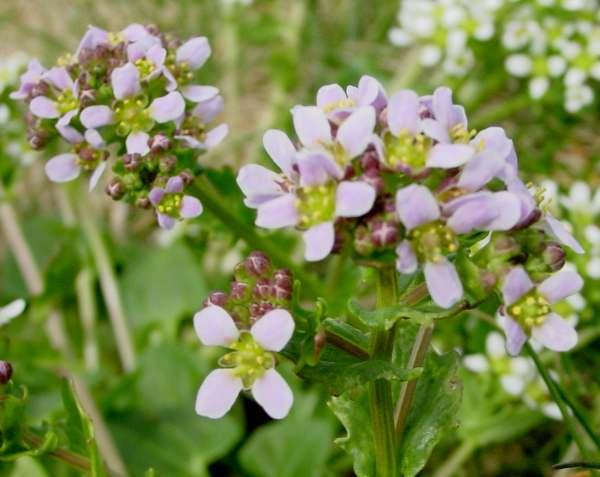
Habitat
This plant is common only near the coast, where it grows on grassy cliffs, in salt marshes and on coastal roadside lanes where winter salting adds to the natural salinity. Inland locations near salt mines and saline springs are also favoured by Common Scurvy-grass.
Heavily salted main roads inland sometimes have central reservations and verges lined with Common Scurvy-grass, but more often the species seen there is the much smaller Danish Scurvy-grass Cochlearia danica. Surprisingly, in view of Common Scurvy-grass's apparent craving for salt, there are also some mountain sites in northern England and in Scotland where Cochlearia officinalis has been recorded.
Blooming Times
The first flowers appear in April, but May is the best month for this member of the Cabbage family. You will see odd patches of scurvy-grass inbloom throughout the summer.
Uses
Sailors ate scurvy-grass when at sea to ward off the debilitating diseaseof scurvy, which is caused by a deficiency of vitamin C.
The symptoms of scurvy are spongy and bleeding gums, bleeding beneath the skin, and extreme weakness. The sharp-tasting leaves of this plant are very high in vitamin C, and at one time scurvy-grass ale was a popular tonic drink. In herbal medicine Cochlearia officinalis was used for its antiseptic properties.
Identification
Usually 15 to 40 cm tall, this untidy biennial plant is best admired from a distance. Its succulent lower leaves, varying from dark green to red and even deep purple, are held close to the ground.

The fragrant, four-petalled flowers, 8 to 15mm across, are usually white but sometimes tinged with mauve or purple. Once the short-lived petals have fallen from the flowers, roundish seed pods swell and ripen.
Distribution
Found throughout Britain and Ireland, Common Scurvy-grass occurs also in coastal regions of northern and central Europe; it is also found, although much less frequently, in some mountainous inland locations.

Habitat
This plant is common only near the coast, where it grows on grassy cliffs, in salt marshes and on coastal roadside lanes where winter salting adds to the natural salinity. Inland locations near salt mines and saline springs are also favoured by Common Scurvy-grass.
Heavily salted main roads inland sometimes have central reservations and verges lined with Common Scurvy-grass, but more often the species seen there is the much smaller Danish Scurvy-grass Cochlearia danica. Surprisingly, in view of Common Scurvy-grass's apparent craving for salt, there are also some mountain sites in northern England and in Scotland where Cochlearia officinalis has been recorded.
Blooming Times
The first flowers appear in April, but May is the best month for this member of the Cabbage family. You will see odd patches of scurvy-grass inbloom throughout the summer.

Uses
Sailors ate scurvy-grass when at sea to ward off the debilitating diseaseof scurvy, which is caused by a deficiency of vitamin C.
The symptoms of scurvy are spongy and bleeding gums, bleeding beneath the skin, and extreme weakness. The sharp-tasting leaves of this plant are very high in vitamin C, and at one time scurvy-grass ale was a popular tonic drink. In herbal medicine Cochlearia officinalis was used for its antiseptic properties.
0
0
文章
Dummer. ゛☀
2017年08月09日

Clematis vitalba photographed at Nicholaston Dunes on the Gower Peninsula in Wales - picture by kind permission of Gordon Benson.
Another common name for this wild flower is Traveller's Joy.
Identification
Pinnate compound leaves each comprising three to five eliptical, toothed leaflets grow in an opposite arrangement. White flowers with conspicuous stamens form dense clusters. Individual flowers are typically 2cm across and have four tepals (in fact they are sepals, not petals).
Blooming times
Old Man's Beard is a perennial clambering plant, producing pale creamy-yellow flowers in July and August and greyish-white fluffy seedheads that persist through the winter months.
The fruiting heads, which appear in autumn, are a mass of white fluffy seeds - hence the common name Old Man's Beard.
Distribution
Traveller's Joy is common throughout southern England and in Ireland but does not venture very far into Scotland. It can also be found throughout Wales.
Habitat
You will find this vine-like plant growing in hedges and on scrubby woodland. It is particularly common in limestone and chalk areas including sand dunes, but we have seen this plant in slightly acidic habitats, too.

Another common name for this wild flower is Traveller's Joy.
Identification
Pinnate compound leaves each comprising three to five eliptical, toothed leaflets grow in an opposite arrangement. White flowers with conspicuous stamens form dense clusters. Individual flowers are typically 2cm across and have four tepals (in fact they are sepals, not petals).

Blooming times
Old Man's Beard is a perennial clambering plant, producing pale creamy-yellow flowers in July and August and greyish-white fluffy seedheads that persist through the winter months.
The fruiting heads, which appear in autumn, are a mass of white fluffy seeds - hence the common name Old Man's Beard.
Distribution
Traveller's Joy is common throughout southern England and in Ireland but does not venture very far into Scotland. It can also be found throughout Wales.

Habitat
You will find this vine-like plant growing in hedges and on scrubby woodland. It is particularly common in limestone and chalk areas including sand dunes, but we have seen this plant in slightly acidic habitats, too.
0
0
文章
Dummer. ゛☀
2017年08月09日

This is a gorgeous wildflower, and in our opinion the most beautiful of the Cistus species that can be seen in the Mediterranean region.
Identification
Sage-leaved Cistus, a member of the Rockrose family, is one of the commonest of several types of Cistus that occur in the Mediterranean Region. The beautiful white flowers can occur singly or in groups of up to four. Unlike other Cistus flowers the petals are relatively un-crumpled in appearance.
Distribution
Cistus salviifolius is native to Mediterranean countries including Portugal, Spain, southern France and Italy. Its range extends southwards to parts of North Africa and eastwards into parts of Asia.
Habitat
This shrub often forms vast colonies and favours dry, rocky places in the maquis and barrocal.
Etymology
The specific epithet salviifolius (often mis-spelt as salvifolius) means 'with sage leaves' - a reference that the leaves are very similar in appearance to thos of the herb known as sage.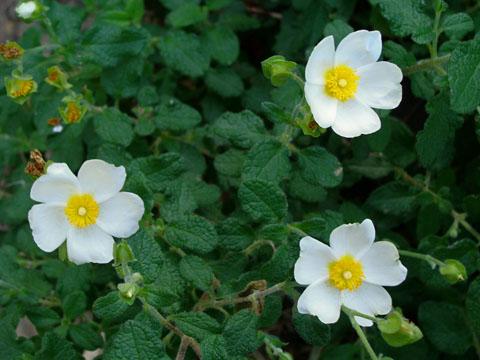
Related species
Along with other Cistus shrubs, Sage-leaved Cistus is parasitised by a strange-looking plant called Cytinus hypocistis,which appears from mid April until June growing on the roots of the bushes.
Identification
Sage-leaved Cistus, a member of the Rockrose family, is one of the commonest of several types of Cistus that occur in the Mediterranean Region. The beautiful white flowers can occur singly or in groups of up to four. Unlike other Cistus flowers the petals are relatively un-crumpled in appearance.

Distribution
Cistus salviifolius is native to Mediterranean countries including Portugal, Spain, southern France and Italy. Its range extends southwards to parts of North Africa and eastwards into parts of Asia.
Habitat
This shrub often forms vast colonies and favours dry, rocky places in the maquis and barrocal.

Etymology
The specific epithet salviifolius (often mis-spelt as salvifolius) means 'with sage leaves' - a reference that the leaves are very similar in appearance to thos of the herb known as sage.

Related species
Along with other Cistus shrubs, Sage-leaved Cistus is parasitised by a strange-looking plant called Cytinus hypocistis,which appears from mid April until June growing on the roots of the bushes.
0
0
文章
Dummer. ゛☀
2017年08月09日

These striking shrubs are very familiar to people familiar with British gardens, but to see them at their best the Iberian Peninsula is the place to go.
Identification
The flowers have rather crumpled-looking petals, some pure white and others white with dark maroon spots. The sticky, oderous substance which comes from the tough, dark green leaves of the plant is used in the perfume industry.
Habitat
From the maquis (areas with shrubs up to 5 metres in height) and well into the hills of Portugal and the Iberian Peninsula in general Gum Cistus flourishes.
Distribution
Gum Cistus, a member of the Rockrose family, is native to Spain, Portugal, southern France and North West Africa. In other places - Cyprus for example - this plant has been introduced and is now naturalised.
Blooming times
In their native (Mediterranean) countries, Gum Cistus flowers can be seen from April to June.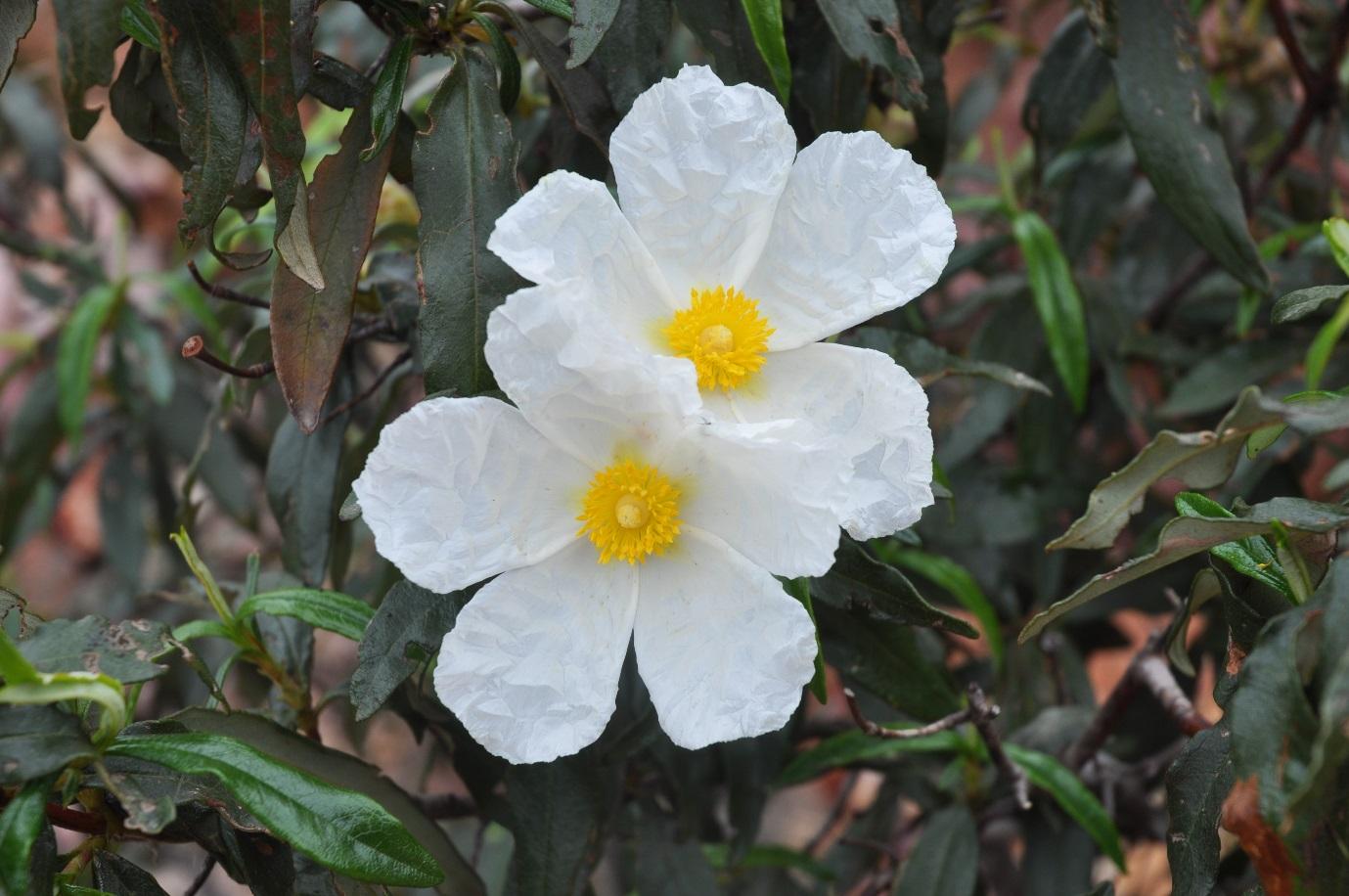
Similar species
Some other species of cistus to appear in the Mediterranean region include Cistus Albidus (Grey-leaved Cistus) and Cistus salviifolius (Sage-leaved Cistus). Many of the bushes are parisitised by Cytinus hypocistis, and the best time to see this fascinating plant (growing around the roots of the cistus bushes) is from mid-April until June.
Identification
The flowers have rather crumpled-looking petals, some pure white and others white with dark maroon spots. The sticky, oderous substance which comes from the tough, dark green leaves of the plant is used in the perfume industry.

Habitat
From the maquis (areas with shrubs up to 5 metres in height) and well into the hills of Portugal and the Iberian Peninsula in general Gum Cistus flourishes.

Distribution
Gum Cistus, a member of the Rockrose family, is native to Spain, Portugal, southern France and North West Africa. In other places - Cyprus for example - this plant has been introduced and is now naturalised.
Blooming times
In their native (Mediterranean) countries, Gum Cistus flowers can be seen from April to June.

Similar species
Some other species of cistus to appear in the Mediterranean region include Cistus Albidus (Grey-leaved Cistus) and Cistus salviifolius (Sage-leaved Cistus). Many of the bushes are parisitised by Cytinus hypocistis, and the best time to see this fascinating plant (growing around the roots of the cistus bushes) is from mid-April until June.
0
0
文章
Dummer. ゛☀
2017年08月09日

Identification
Cistus albidus grows up to 1.5m in height, although most plants are little more than half this height. The hairy pale grey-green leaves are oblong to elliptical and have three prominent veins. The flowers are 4 to 6 cm across and have five purplish-pink petals backed by five sepals.
The leaves of cistus plants are very tough. The flowers, by comparison, seem very fragile and have wafer-thin, crumpled looking petals: they are nontheless beautiful for that, and it is easy to see why cistus is considered such a well-loved addition to northern European gardens.
Habitat
In the UK these shrubs are much-loved garden plants, but it is in the Mediterranean region that they really come into their own: vast tracts of hillsides (particularly in Portugal and Spain) are smothered with various species of these members of the Rockrose family.
Blooming times
Grey-leaved Cistus produces flowers from March to June and can be found in maquis, garrigue, open woodland, on steep slopes and rocky ground. Some of the other cistus species to be found in the Mediterranean include Cistus ladanifer (Gum Cistus), and Cistus salviifoloius (Sage-leaved Cistus).
Cistus albidus grows up to 1.5m in height, although most plants are little more than half this height. The hairy pale grey-green leaves are oblong to elliptical and have three prominent veins. The flowers are 4 to 6 cm across and have five purplish-pink petals backed by five sepals.

The leaves of cistus plants are very tough. The flowers, by comparison, seem very fragile and have wafer-thin, crumpled looking petals: they are nontheless beautiful for that, and it is easy to see why cistus is considered such a well-loved addition to northern European gardens.

Habitat
In the UK these shrubs are much-loved garden plants, but it is in the Mediterranean region that they really come into their own: vast tracts of hillsides (particularly in Portugal and Spain) are smothered with various species of these members of the Rockrose family.

Blooming times
Grey-leaved Cistus produces flowers from March to June and can be found in maquis, garrigue, open woodland, on steep slopes and rocky ground. Some of the other cistus species to be found in the Mediterranean include Cistus ladanifer (Gum Cistus), and Cistus salviifoloius (Sage-leaved Cistus).
0
0



